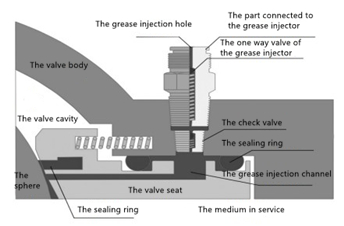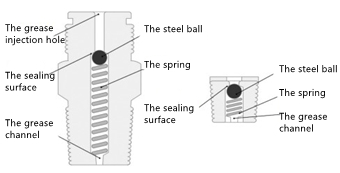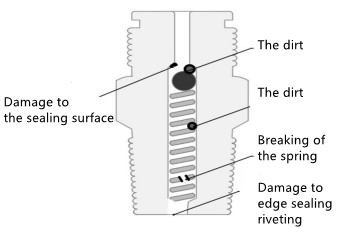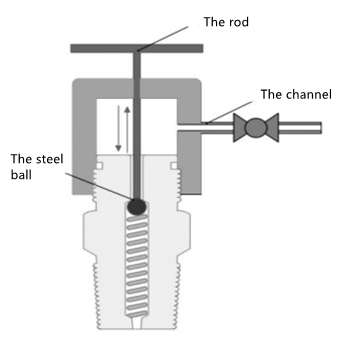Natural gas stations and valve chambers are the key control parts in the pipeline system. Ball valves are often used to cut off, distribute and change the flow direction of the medium. If the ball valve fails, it will lead to a lot of waste of energy, especially after an emergency. The failure of the valve will cause immeasurable losses, and may cause fires of varying degrees. Meanwhile, it will also affect the progress of some important projects, making enterprises suffer great losses. In order to ensure the normal operation of the ball valve in operation, it is often necessary to inject cleaning fluids to clean the valve seat and the sealing surface of the ball, inject grease for lubrication and maintenance, and inject sealing grease for emergency sealing under special conditions. Therefore, a grease injection mechanism is set up in the ball valve structure. The grease injection nozzle is a key component in the grease injection mechanism of the ball valve. The medium leaking from the grease injection hole on the upper part of the grease injection nozzle often affects the normal operation and safe production of the ball valve.
1. The working principle of the ball valve's grease injection mechanism
The grease injection mechanism of common ball valves is shown in Figure 1. Pressurize the cleaning liquids or grease by 10 to 20MPa through the grease injector connected outside the grease injection nozzle, and the grease passes through the internal channel of the grease injection nozzle, and internal grease channel of the valve seat to the sealing ring position of the seat to realize the lubrication and sealing of the valve seat and the sealing surface of the ball, reduce the operating torque when the valve is opened or closed, and extend the service life of the valve.

Figure 1 The grease injection mechanism of the ball valve
2. Structural principles and causes of failures of grease injection nozzles of one-way valves and check valves
2.1 The structure principle of grease injection nozzles of one-way valves and check valves
The structure of grease injection nozzles of one-way valves and check valves are the same, and they are generally composed of steel balls, springs, grease channels and bodies with connecting threads (as shown in Figure 2).

Figure 2 Structures of grease injection nozzles of one-way valves and check valves
Working principles: The high-pressure grease enters the channel through the grease injection hole; the spring is compressed and contracted, and the steel ball is displaced downward. The one-way valve of the grease injection nozzle is opened. When the grease enters the check valve, the check valve is opened by the same principle. The grease enters the valve seat through the open channel. After the grease injection is completed, the injection of the high-pressure grease is removed. Under the action of the spring return and the internal pressure of the ball valve, the steel ball moves upward to the sealing surface, and the one-way valve of the grease injection nozzle and check valve are closed.
2.2 Reasons for leakages of grease injection holes
The grease injection mechanism of the ball valve has a connection channel between the inside and the outside of the valve body. When the one-way valve of the grease injection nozzle and the check valve fail at the same time, under the action of the pressure of the medium inside the valve body, the medium will overflow from the connecting channel of the grease injection mechanism of the ball valve, causing leakages at the grease injection hole of the grease injection nozzle. Generally, causes of failures of one-way valves of grease injection nozzles and check valves mainly include failures of sealing surfaces and pushback of the spring. Take the one-way valve of the grease injection nozzle as an example (Figure 3).

Figure 3 The schematic diagram of the leakage of the one-way valve of the grease injection nozzle
(1) The sealing surface fails. This kind of failure includes the failure caused by the influence of corrosion and other factors on the body of the steel ball and the sealing surface, and the debris such as sand, metal chips and hardened grease being stuck between the two, causing a failure of the sealing. In actual situations, most of the check valves leak after being used for a year.
(2) The push-back and reset of the spring fails. This type of failure includes defects of materials of springs, lack of manufacturing processes, fracture caused by hydrogen embrittlement or stress corrosion; plastic deformation of the spring happens due to excessive grease injection pressure. The spring is blocked due to dirt in the grease injection channel and the damage to the riveting edge, causing the spring not to be able to return to its original position, and the sealing of the channel will fail.

Figure 4 The schematic diagram of the cause of the leakage of the one-way valve of the grease injection nozzle
